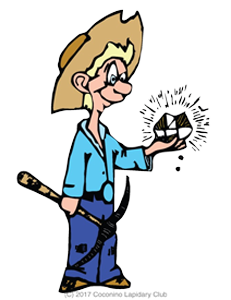What Are You Curious About? I am from Wisconsin, staying in Winslow with girlfriend who is a nurse.. I just became interested in rocks and minerals and need help identifying some specimens…. thank you Your specimens are three forms of quartz, in which the crystals are of microscopic size so you can’t see their shape.. . . Read More
Ask An Expert
Need Help Identifying These Specimens
Who Is That Masked Mineral Man?
I’ve been an avid collector of mineral specimens from around the world since my experience, at the age of 13, of finding a beautiful black tourmaline crystal while on a Boy Scout hiking adventure. We were in the upper limits of the gem mining Pala District in San Diego County, California. I’m now 84 and still. . . Read More
What is the Difference Between a Rock and a Mineral?
According to the USGS website, “A mineral is a naturally occurring inorganic element or compound having an orderly internal structure and characteristic chemical composition, crystal form, and physical properties”. “A rock is an aggregate of one or more mineral, or a body of undifferentiated mineral matter”. For more information about rocks and minerals, be sure. . . Read More
USE OF COLOR IN MINERAL IDENTIFICATION
In some minerals color is directly related to a metallic element, is characteristic, and can be useful in identification. As examples, azurite as shown in Figure 1A, is always blue due to the presence of copper, and rhodochrosite, shown in Figure 1B, is always pink to red due to the presence of manganese,. However minerals such as fluorite, colorless in it self, can be yellow, blue, purple, or green due to low concentrations of metal impurities.
USE OF CRYSTAL FORMS AND HABITS IN MINERAL IDENTIFICATION
The atoms within the crystal of a mineral are arranged in a regular fashion to form a lattice, and the crystal exhibits a shape with surface regularity which reflects its internal symmetry[Ref1]. The shape of a crystal is often typical of a mineral. and often typical the location where found; thus, crystal shape comprised of crystallographic forms modulated by crystal habit can be a useful tool in mineral identification.
USES OF CLEAVAGE, PARTING, AND FRACTURE IN MINERAL IDENTIFICATION
Cleavage in a mineral is the tendency for the crystal to split along definite crystallographic planes as exemplified by the rhombohedron cleaved from a calcite crystal shown in Figure 1[Ref1]. These planes of weakness are present within a regular repeating array of atoms and ions within the crystal and are always parallel to a potential face of the crystal.
FRACTURE IN MINERAL IDENTIFICATION
Fracture in mineralogy is the texture and shape of the surface formed when the mineral is fractured. Fracture differs from cleavage and parting, which involve clean splitting along a plane surface, as it produces rough irregular surfaces [Ref1]. The appearance of fracture surfaces among minerals is highly varied and is a useful tool in identification. In this part of my Blog I’ll describe the fracture surfaces broadly seen in minerals.
Meteorites
Meteorites are stuff from outer space; each is a solid piece of debris which formed from dust within the protoplanetary disc or from object such as an asteroid, planetesimal, or planet, and which travels through space and falls through the atmosphere to the surface of earth. As alien objects which fall dramatically they have evoked. . . Read More
HARDNESS: A MECHANICAL PROPERTY OF USE IN IDENTIFYING MINERALS
Along with the colors and crystal forms of minerals, their mechanical properties such as the hardness. tenacity, and habits of structural failure can be very useful tools in identifying an unknown mineral. In this first Blog on the use of mechanical properties in identifying minerals I’ll focus on hardness and describe the Moh’s Hardness Scale,. . . Read More
